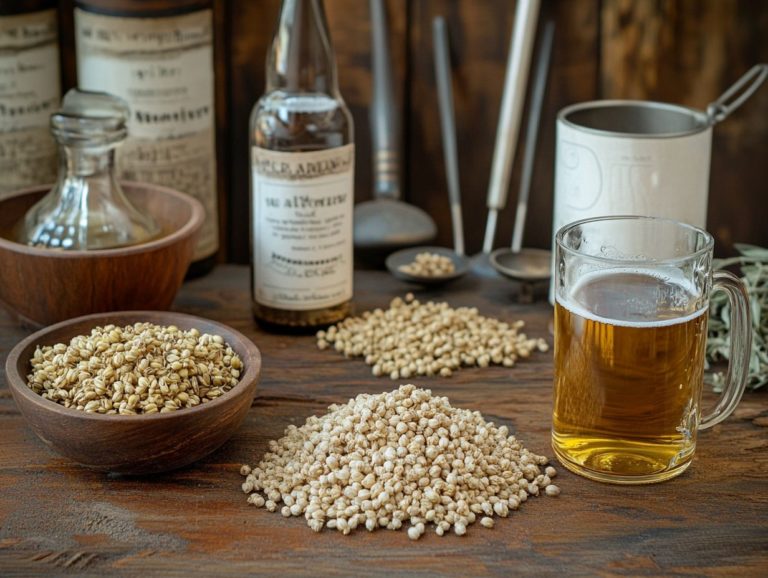What Is the Role of Malt in Brewing?
Malt serves as a cornerstone of brewing beer, playing an essential role in shaping the flavor, aroma, and color of your brew.
This article delves into the impact of malt, exploring its various types and contributions to the brewing process. You ll discover the importance of quality malt in achieving a superior beer experience, including insights into specialty malts like crystal malts and roasted malts.
We ll also clarify common misconceptions about malt, including its role in sugar production and its applications beyond just beer.
Get ready to discover how malt transforms your favorite brews!
Contents
- Key Takeaways:
- What is the Role of Malt in Brewing?
- What is the Importance of Malt in the Brewing Process?
- What is the Importance of Quality Malt in Brewing?
- How Does the Quality of Malt Affect the Quality of Beer?
- What Factors Contribute to the Quality of Malt?
- What are Some Common Misconceptions about Malt in Brewing?
- Frequently Asked Questions
Key Takeaways:
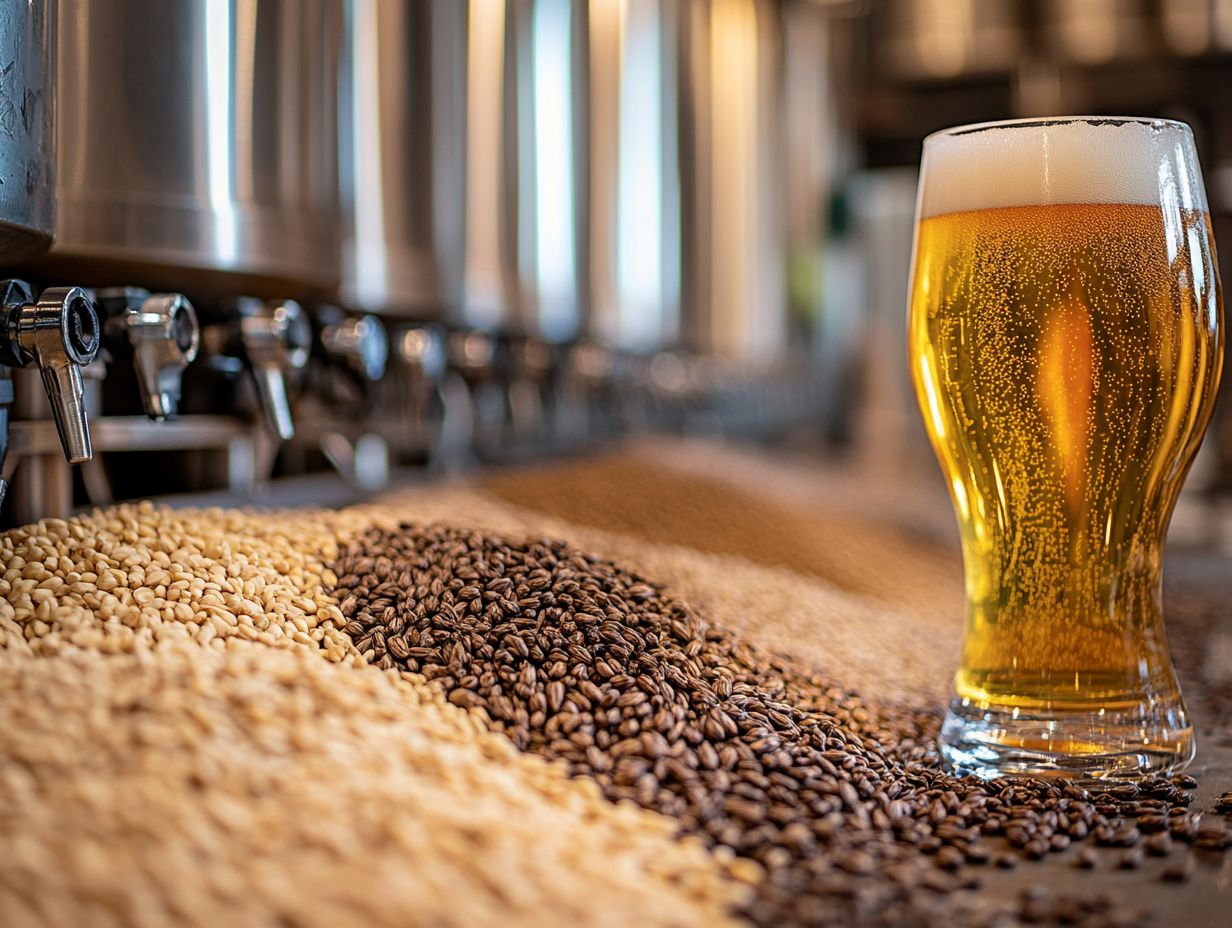
- The flavor of beer is heavily influenced by the type of malt used in brewing, including varieties like barley malt, wheat malt, and rye malt.
- The quality of malt directly impacts the quality of beer, making it an important aspect to consider for brewers and home brewing enthusiasts alike.
- Malt is not just a source of sugar in beer; it also contributes to color and can’t be easily substituted with other ingredients.
What is the Role of Malt in Brewing?
Malt holds a pivotal position in the brewing process, acting as one of the key ingredients that shapes the unique flavors, aromas, and overall character of beer. It is crafted from grains like barley, wheat, and rye through a meticulous malting process that involves soaking, germinating, and drying these grains to cultivate malt sugars, which are vital for fermentation and producing sweet wort.
This intricate process not only dictates the sweetness and body of the beer but also influences its alcohol content and carbonation levels. Thus, malt becomes a critical component in both commercial brewing and home brewing practices.
How Does Malt Affect the Flavor of Beer?
Malt plays a pivotal role in defining the flavor profile of your beer, offering essential sugars that yeast ferments into alcohol and CO2. It also introduces a spectrum of aromas and flavors that can range from sweet to nutty or even smoky, depending on the malt characteristics.
These varied malt flavors are influenced by several factors, including the type of grain, the intensity of roasting, and the nuances of the malting process itself. For example, caramel malts lend a rich sweetness and a touch of toffee, striking a harmonious balance with the bitterness of hops.
Meanwhile, darker malts can infuse your brew with layers of chocolate or coffee essence, enhancing styles like stouts and porters. Smoked malts can introduce unique smoky flavors that add complexity to your brew.
The relationship between malt and yeast can give rise to intricate flavors that further shape the final taste. Classic styles such as M rzen or Vienna lagers prominently feature a malty backbone with notes of toasted bread, underscoring the critical role that malt plays in the world of brewing.
What are the Different Types of Malt Used in Brewing?
In the world of brewing, you’ll encounter a fascinating array of malts, each bringing its distinctive flavors and characteristics to your beer. These include barley malt, wheat malt, rye malt, and a variety of specialty malts like crystal malts, roasted malts, and smoked malts.
By understanding the nuances of each malt type, you can craft specific profiles that appeal to a range of palates. For instance, barley malt is your go-to for versatility; it serves as the backbone of most beers, offering a rich, malty sweetness accompanied by delightful hints of biscuit or nutty flavors.
Wheat malt, in contrast, bestows a light, refreshing body with a subtle creaminess, making it perfect for styles like hefeweizens. Rye malt adds a spicy character, enriching both ales and lagers with complexity.
Specialty malts like crystal malts bring caramel sweetness and color, while roasted malts contribute bold coffee or chocolate notes, enhancing the richness of stouts and porters.
Your choice of malts will directly influence not just the flavor but also the aroma, mouthfeel, and overall appearance of the beer, ultimately shaping your brewing experience into something truly exceptional.
What is the Importance of Malt in the Brewing Process?
Malt plays a pivotal role in the brewing process, serving as the primary source of fermentable sugars necessary for alcohol production. It also enhances the overall flavor, body, and mouthfeel of the beer.
This single ingredient significantly influences both your choice of brewing ingredients and the fermentation process. This impacts everything from malt extraction to the final malt flavor of the beer.
During the mashing stage, you’ll mix malt with hot water, activating enzymes that convert starches into those all-important fermentable sugars. This essential transformation shapes the character of your beer, allowing you to achieve the desired sweetness and complexity that makes your brew stand out.
The process involves critical malting steps that ensure optimal enzymatic activity and sugar conversion.
As you progress to the boiling stage, malt continues to contribute additional flavors and impacts the color and clarity of your creation. The quality of the malt you select is crucial; high-quality malts will lead to a more balanced flavor profile and consistent fermentation.
On the other hand, inferior malts can introduce unwanted flavors and create an uneven alcoholic strength. Thus, paying attention to malt quality is essential in every stage of brewing.
Ultimately, your careful selection of malt influences every subsequent stage of brewing, highlighting its significance in the art of crafting the perfect beer.
What is the Importance of Quality Malt in Brewing?
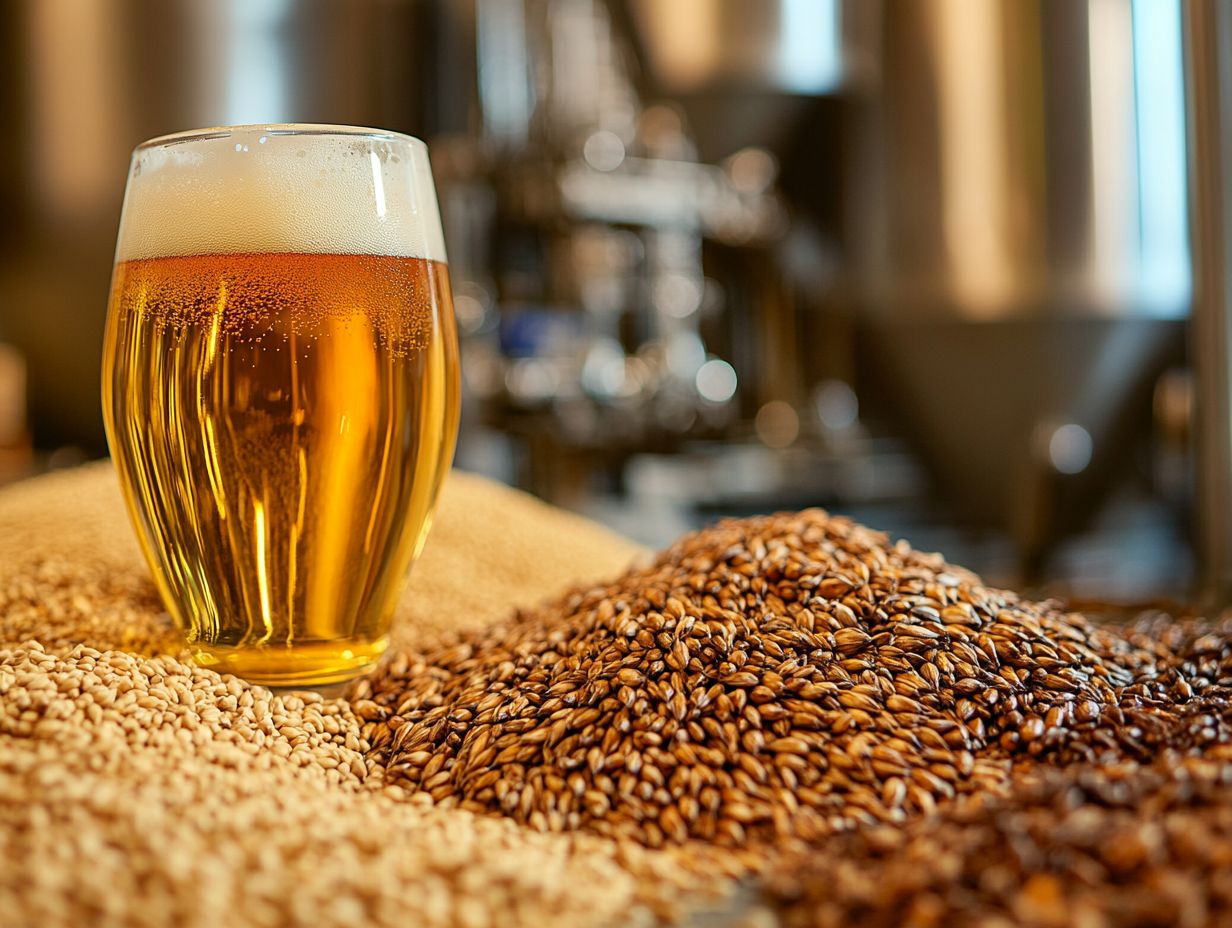
Quality malt is essential in brewing, as it significantly influences the flavor, aroma, and consistency of the final product.
By choosing the right malt, you have the power to create beers that align perfectly with your desired taste profiles and meet market standards. This makes selecting high-quality malt from reputable maltsters a critical step in your brewing process, setting the foundation for exceptional brews.
How Does the Quality of Malt Affect the Quality of Beer?
The quality of malt profoundly influences the quality of your beer, shaping everything from flavor profiles to fermentation efficiency and even the stability of the final product. Opting for high-quality malt will elevate your beer, imbuing it with complex and desirable characteristics that are often highlighted in beer reviews.
Consider the enzymatic activity in malt, which plays a vital role during the mashing process. It breaks down starches into fermentable sugars.
If you choose malt that is poorly modified, you risk encountering limited enzymatic capability, resulting in incomplete conversion and a disappointing drop in alcohol content. This underscores the importance of understanding malt production techniques.
Flavor compounds, like melanoidins (which add richness) and phenols (which contribute unique aromas), are developed during the malting process. When you use low-quality malt, these compounds may not be produced effectively.
This can lead to a beer that lacks depth and richness. For instance, selecting malt that is undersized or sourced from less-than-ideal conditions can introduce unwanted flavors or even sour notes, severely compromising the appeal of your final product.
What Factors Contribute to the Quality of Malt?
Several factors significantly influence the quality of malt, including the type of grain you choose, the care taken during the malting process, and how you source your grains from farmers.
The conditions during barley production ultimately affect the final malt extraction and its unique characteristics. Brewing techniques and attention to malting steps further refine the quality of the malt.
These elements are crucial in determining the enzymatic activity, flavor profile, and color of the malt each playing a vital role in the intricate brewing process.
Agricultural practices, such as soil quality, climate, and crop management techniques, directly impact the grain’s sugar content and protein levels.
Moreover, the malting techniques you employ, including germination and kilning temperatures, can substantially alter enzyme development and the caramelization of sugars, which in turn affects the taste and aroma of the beer.
Finally, ensuring proper storage conditions is essential to prevent moisture absorption and the emergence of unwanted flavors, allowing the malt to retain its optimal quality until it’s time to brew your masterpiece.
How Can Brewers Ensure They Are Using High-Quality Malt?
You can ensure that you’re using high-quality malt by forging strong relationships with reputable maltsters and conducting regular quality checks.
Stay informed about malt production techniques that uphold high standards.
By actively evaluating sensory aspects such as aroma, flavor, and color, you can better assess the malt’s suitability for your specific brewing projects. It s essential for you to delve into the malt specifications provided by your suppliers, as this information reveals the performance characteristics of the malt, including its modification degree and enzyme activity.
Modification degree refers to how thoroughly the malt has been processed, affecting its fermentability. Enzyme activity is the ability of the malt to break down starches into sugars during brewing.
Choosing maltsters who prioritize transparency throughout the supply chain not only fosters trust but also empowers you to make informed decisions about your ingredients. Engaging in open communication with maltsters can yield valuable insights into sourcing practices and quality control measures, ultimately enhancing your brewing process and ensuring the optimal malt characteristics for your beer.
What are Some Common Misconceptions about Malt in Brewing?
Malt is often misunderstood as merely a source of sugar in brewing beer, but it significantly impacts flavor, aroma, and color. Misconceptions also exist around malt extract and the simplicity of the malting process, overlooking the intricate steps and skills involved.
Despite its essential role in the brewing process, many misconceptions about malt persist. For instance, some may believe that it is the sole source of sugar in beer or that it can be easily replaced with other ingredients.
Such misunderstandings can lead to a skewed perception of brewing techniques and ultimately impact the quality of the beer.
Is Malt the Main Source of Sugar in Beer?
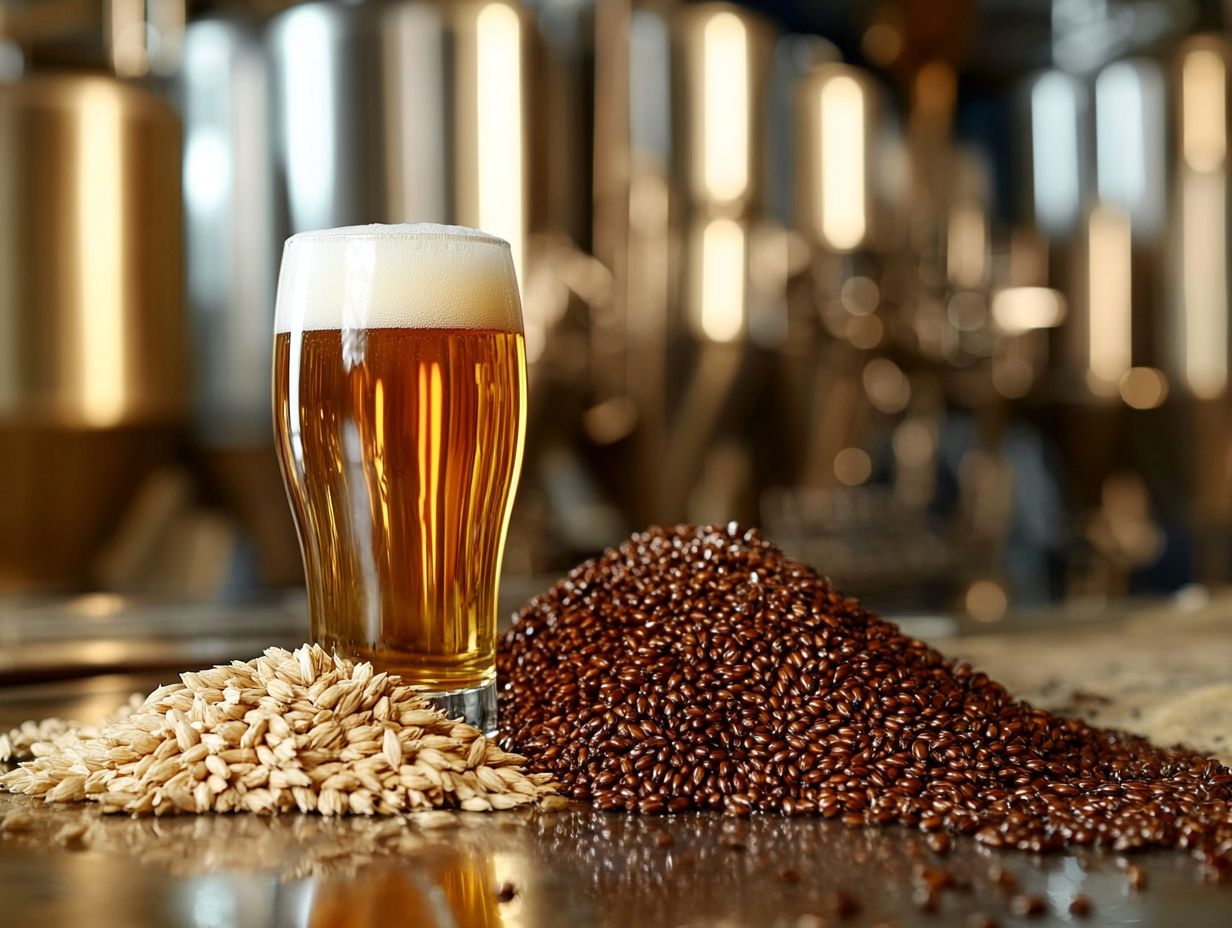
Malt is certainly the star player when it comes to fermentable sugars in beer, but it’s far from the only ingredient in the game; adjuncts also step in to contribute sugars during fermentation.
These adjuncts, which might include corn, rice, or sugar syrups, are vital in crafting a diverse array of flavors and textures in the final brew. By incorporating various sugars from these sources, you have the power to shape not just the sweetness and body of your beer, but also its overall fermentation profile.
Each type of sugar you choose adds its distinct characteristics, influencing yeast activity and, in turn, the aroma and taste profile of the beer. For example, simple sugars can lead to a cleaner fermentation, while more complex sugars are likely to produce richer, fuller-bodied brews. This highlights the importance of selecting the right ingredients to achieve the flavor outcome you desire.
Can Malt be Substituted with Other Ingredients in Brewing?
While malt serves as a cornerstone of brewing, you might find that some brewers experiment with alternative ingredients to craft distinctive flavor profiles. However, it’s important to note that these substitutions can significantly transform the characteristics of the final beer.
By incorporating adjunct grains like corn, rice, or oats, you can achieve lighter, crisper profiles that appeal to those who savor refreshing lagers. Syrups such as malt extract or honey contribute unique flavors and sweetness, influencing both fermentation and mouthfeel.
These alternatives not only necessitate adjustments in brewing techniques often involving changes in temperature and enzyme activity but also have a profound effect on the beer s aroma and taste, allowing for a truly innovative approach. This opens up exciting possibilities for creating seasonal brews or specialty beers that captivate adventurous palates.
Explore different malts and adjuncts in your next brew to unlock new flavors and experiences!
Does the Color of Malt Affect the Color of Beer?
The color of malt plays a crucial role in determining the hue of your beer. Darker malts, like roasted and caramel varieties, impart rich, deep colors and distinct flavor notes to your brew.
With such a diverse selection of malts at your disposal, you can craft an impressive spectrum of shades, ranging from pale golden ales to robust, dark stouts. This transformation is the result of the Maillard reaction, which is a process that occurs when heat is applied to sugars and proteins, creating complex flavors and colors.
As the grains are heated, these reactions unlock a myriad of colors and flavors. This enhances not only the visual allure of the beer but also its aromatic and taste profiles.
Your brewing techniques such as the duration of the mash and the temperature at which it occurs can further refine these colors, ensuring that each batch becomes a unique and thoughtfully crafted masterpiece.
Is Malt Only Used in Beer Brewing?
While you may primarily associate malt with the art of beer brewing, its applications extend far beyond that realm. Malt is an essential ingredient that brings life to various delightful products!
Malt is also a key player in the production of malt whiskey, malt vinegar, and even certain baked goods, highlighting its remarkable versatility.
In addition to these uses, malt holds a significant position in the food industry as a natural sweetener and flavor enhancer. You ll find it enhancing a variety of products, from cereals to snacks, enriching the taste experience.
Its enzymatic properties are invaluable in brewing and distillation processes. They facilitate the conversion of starches into fermentable sugars a fundamental component of alcohol production. You can even find malted grains making their way into health foods and protein bars, where they offer substantial nutritional benefits.
The sweet, rich flavors that malt brings also elevate confections and sauces, establishing it as a vital ingredient in an array of culinary applications.
Frequently Asked Questions
What is the role of malt in brewing?
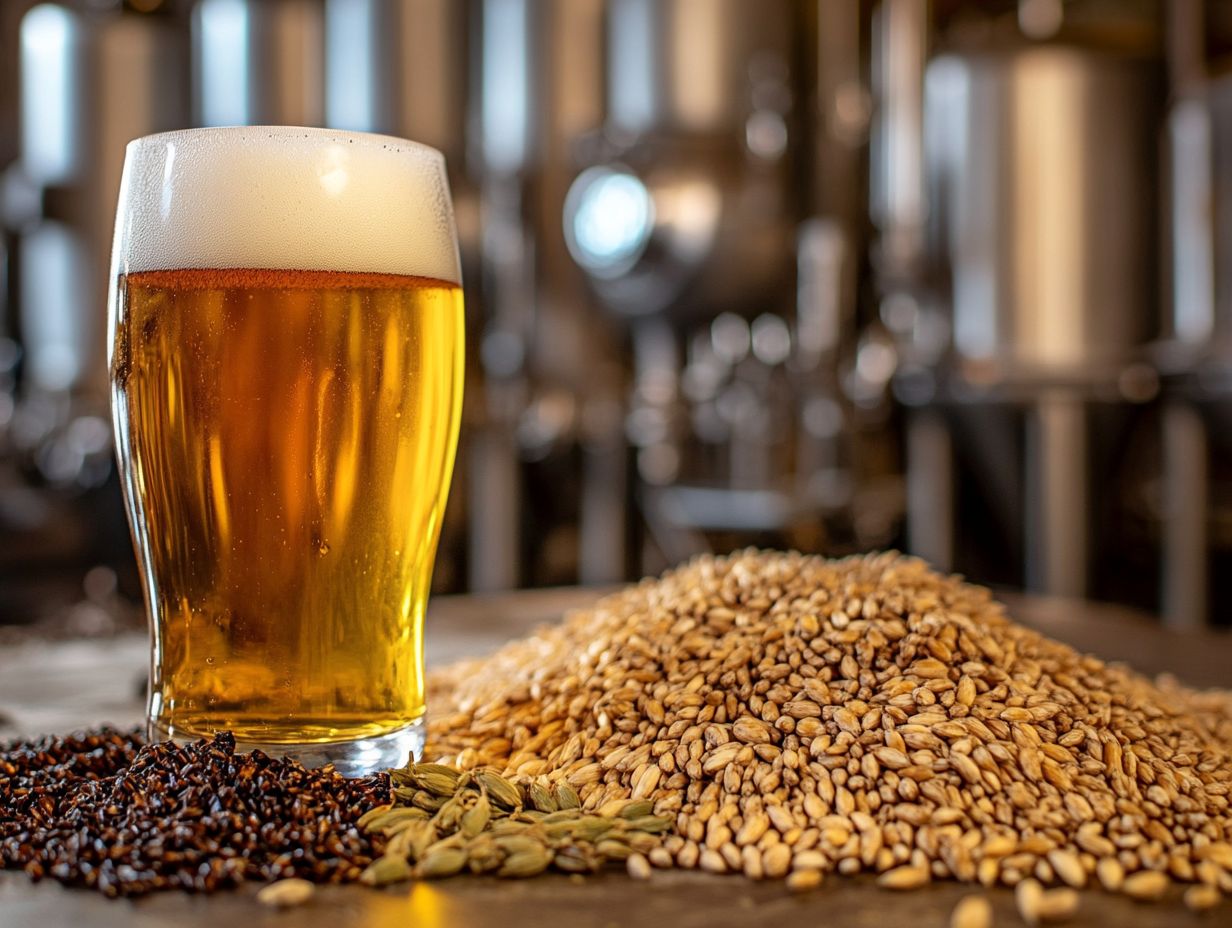
Malt is a key ingredient in the brewing process that provides fermentable sugars and flavor to beer.
What type of grains are used to make malt for brewing?
Barley is the most commonly used grain for making malt in brewing, but wheat, rye, and other grains can also be used.
How is malt made for brewing?
Malt is made by sprouting and drying grains. This process converts starches into fermentable sugars and develops flavors in the grains.
What does malt contribute to the flavor of beer?
Malt adds sweetness, body, and complexity to the flavor of beer, as well as providing color and aroma.
How does the amount of malt used affect the beer?
The amount of malt used in brewing can greatly impact the strength, flavor, and color of the beer.
Can different types of malt be used in the same batch of beer?
Yes, brewers often use a combination of different types of malt to achieve a desired flavor profile and balance in their beer.




